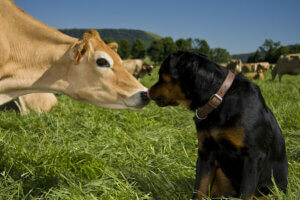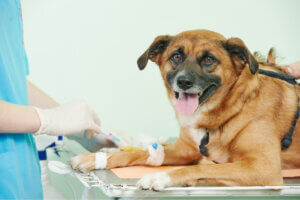Canine Neosporosis: Causes, Symptoms and Treatment


Written and verified by the biologist Samuel Sanchez
Neospora caninum, a coccidia parasite hosted by horses, cattle, and other mammals, causes the infectious disease called canine neosporosis. The dog is its only permanent host, so the pathogen usually settles in its muscles in the form of tissue cysts.
In general, many of the infected dogs are asymptomatic, but affected puppies can get a very poor prognosis. If you want to know more about canine neosporosis and how to identify it, read on.
What is canine neosporosis?
As previously mentioned, this infection is caused by the coccidia Neospora caninum, an obligate intracellular parasite. Until recently, scientists believed that the dog was the only definitive host, but studies revealed that other canids such as coyotes, gray wolves, and dingoes can also be definitive hosts.
Professional veterinary websites estimate that the prevalence of the parasite —the number of infected dogs in a given population— varies from 0 to 100% depending on the region. In the United States, for example, records show that approximately 7% of all dogs test positive in certain areas. In England, the prevalence is between 5.5-23.6%.
Stray dogs and those in contact with livestock are more likely to become infected.
The parasite has 3 forms according to the stages of its life cycle. They’re the following:
- Oocysts: An analog of eggs, which form in dogs’ intestinal tracts and are excreted with feces.
- Tachyzoites: The infectious forms that proliferate from oocysts once they’re ingested by a dog.
- Bradyzoites: Which create cysts in the muscles of the animal.

Symptoms
As we’ve said, many infected dogs never show symptoms. Unfortunately, some adult dogs and puppies are more likely to show certain clinical signs. These signs are the result of tachyzoites causing inflammation and necrosis in affected tissues.
Thus, the most common symptoms are neuromuscular. Among them, we find the following:
- The typical symptom of the infection occurs in puppies under 6 months of age. These can produce paralysis of the hind legs, which follows an upward pattern. This clinical evidence usually begins to appear at 3-9 weeks of age.
- Widespread muscle atrophy occurs in an upward pattern. The hind legs are usually more affected at first than the front ones.
- Difficulty in swallowing, jaw paralysis, and marked cervical weakness can come next.
- Other complications include pneumonia, seizures, anorexia, weakness, heart muscle inflammation, and even death.
- In puppies that are symptomatic, muscle atrophy is progressive and results in continued contraction of the affected muscles. When this clinical picture appears, the prognosis is very poor.
Treatment
We must bear in mind that there’s no 100% effective treatment to date. Some antibiotics administrated to puppies have some success, but medication doesn’t guarantee the animal’s survival. Clindamycin is the drug of choice for 3 weeks up to 2 months in almost all cases.
In general, adult dogs tend to respond better to treatment than puppies. Once the neuromuscular clinical symptoms appear in the animal, the prognosis becomes extremely poor.
If treatment is prompt and administered before paralysis sets in, the prognosis improves slightly.
Prevention of canine neosporosis
As there’s no definitive treatment, the best measure is to prevent the disease. Veterinary websites inform us that pregnant dogs can transmit the pathogen to their puppies by way of the placenta, so we must be very careful with pregnant females.
In general, dogs get the disease by maintaining close contact with meat or cattle tissues that have bradyzoite cysts. Vets still don’t know if the oocysts in the environment are also infectious for dogs —although they’re for livestock. For this reason, the best measure is to limit dog-livestock contact as much as possible.

As you may have noticed, canine neosporosis often goes unnoticed but, when it begins to manifest itself, it can become lethal. If there are signs of the illness in your region, limit your dog’s contact with livestock and rural environments. In case of infectious diseases, it’s always better to prevent than to cure.
All cited sources were thoroughly reviewed by our team to ensure their quality, reliability, currency, and validity. The bibliography of this article was considered reliable and of academic or scientific accuracy.
- Neosporosis, capcvet.org. Recogido a 21 de diciembre en https://capcvet.org/guidelines/neosporosis/
- Dubey, J. P., & Lindsay, D. S. (1996). A review of Neospora caninum and neosporosis. Veterinary parasitology, 67(1-2), 1-59.
- Dubey, J. P., Schares, G., & Ortega-Mora, L. M. (2007). Epidemiology and control of neosporosis and Neospora caninum. Clinical microbiology reviews, 20(2), 323-367.
- McAllister, M. M., Dubey, J. P., Lindsay, D. S., Jolley, W. R., Wills, R. A., & McGuire, A. M. (1998). Rapid communication: Dogs are definitive hosts of Neospora caninum. International journal for parasitology, 28(9), 1473-1479.
This text is provided for informational purposes only and does not replace consultation with a professional. If in doubt, consult your specialist.